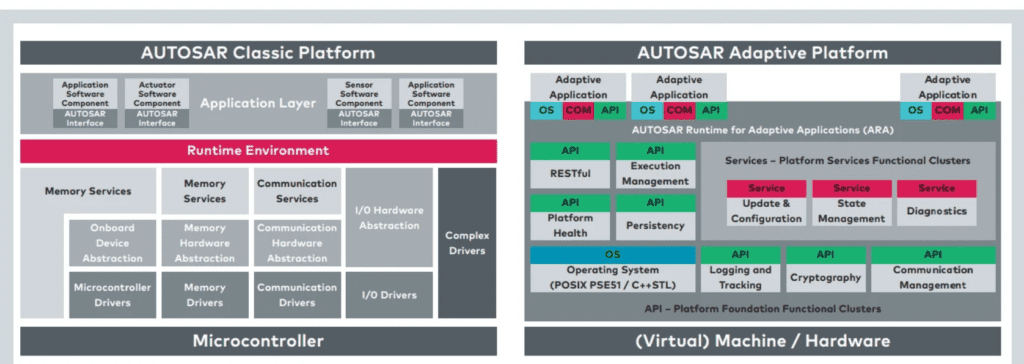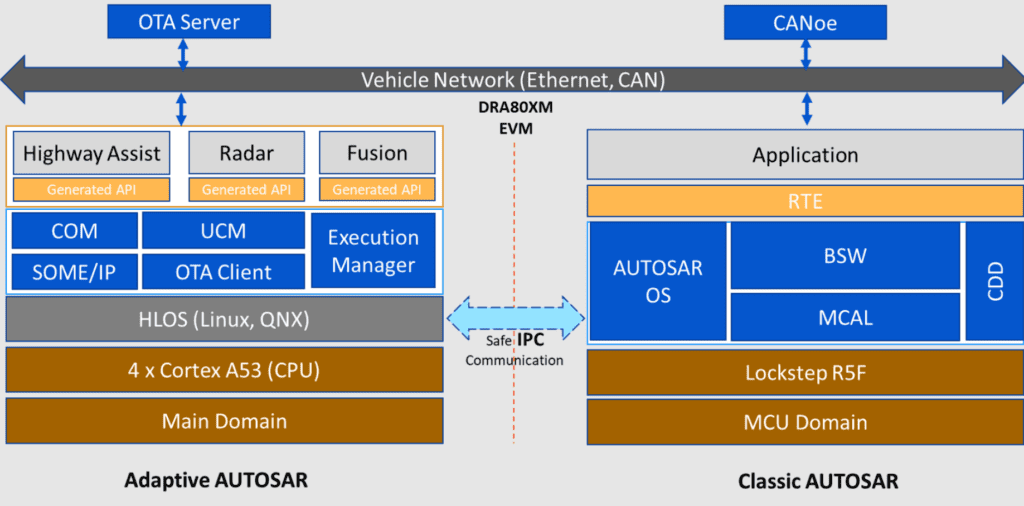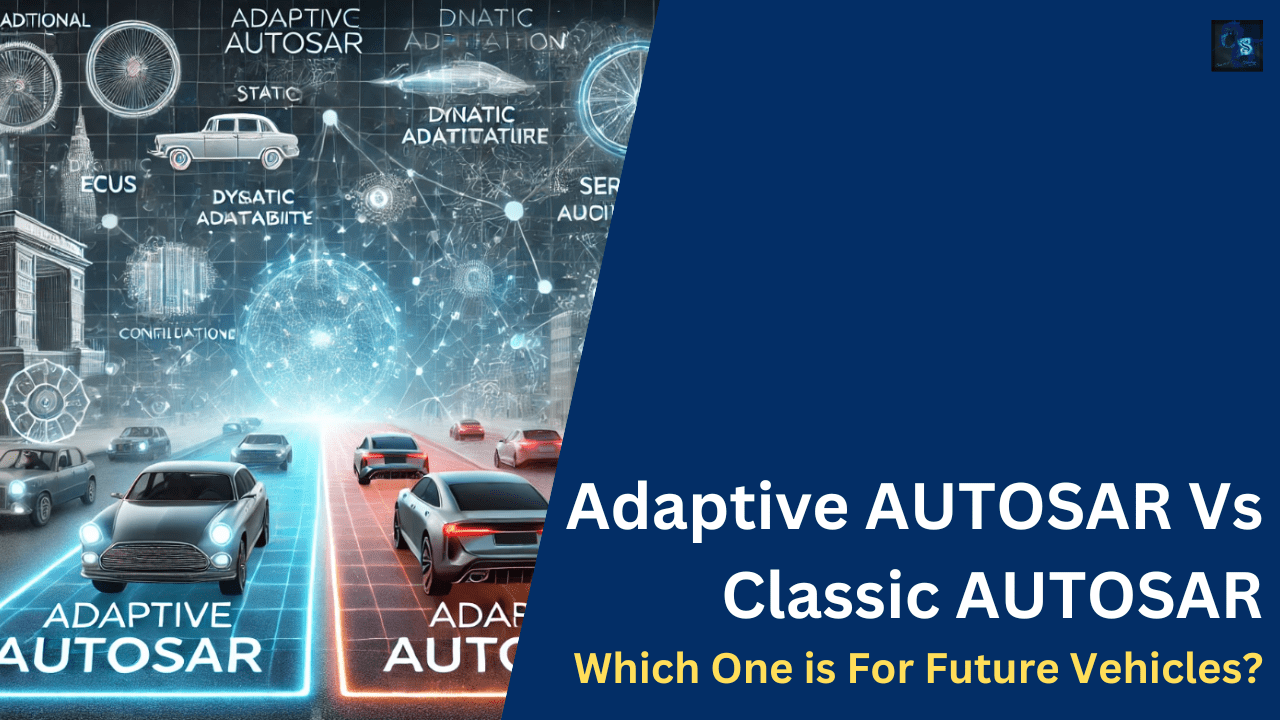Adaptive AUTOSAR Vs Classic AUTOSAR: Which One For Future Vehicles?
Hello guys, welcome back to our blog. Here in this article, I will discuss Adaptive AUTOSAR Vs Classic AUTOSAR, and which one is best for the future vehicles.
Ask questions if you have any electrical, electronics, or computer science doubts. You can also catch me on Instagram – CS Electrical & Electronics
- How V2X Communication is Transforming Connected Vehicle Technology
- Comparing Embedded Coder, Simulink Coder, And MATLAB Coder In Automotive Applications
- Every Automotive Engineer Must Have Expertise In These Domains
Adaptive AUTOSAR Vs Classic AUTOSAR
The rapid advancement of automotive technology, particularly in autonomous driving and connected vehicles, has driven significant changes in automotive software architecture. The AUTOSAR (Automotive Open System Architecture) standard, which has been a fundamental framework for automotive software development, has evolved to address these changes.
Classic AUTOSAR, established for traditional Electronic Control Units (ECUs), is now complemented by Adaptive AUTOSAR, designed for high-performance computing platforms. This article explores the key differences between Adaptive AUTOSAR and Classic AUTOSAR and evaluates which one is better suited for future vehicles.

Understanding Classic AUTOSAR
Classic AUTOSAR is a standardized software architecture used in embedded automotive systems. It is primarily designed for real-time applications and safety-critical systems in vehicles.
Key Characteristics of Classic AUTOSAR
- Static Configuration: Classic AUTOSAR relies on pre-configured software components with limited runtime adaptability.
- Real-Time Capabilities: Supports hard real-time and deterministic execution, making it ideal for powertrain, body control, and safety-critical applications.
- Layered Architecture: Based on a layered architecture comprising the Basic Software (BSW), Runtime Environment (RTE), and Application Layer.
- Limited Flexibility: Due to its predefined configuration, it lacks dynamic adaptation, limiting its use in modern autonomous and connected vehicle functions.
Applications of Classic AUTOSAR
- Powertrain control systems
- Chassis control (ABS, ESP, etc.)
- Body electronics (lighting, HVAC, etc.)
- Safety-critical systems (airbags, ADAS, etc.)
Understanding Adaptive AUTOSAR
Adaptive AUTOSAR was introduced to address the growing demand for high-performance computing, over-the-air updates, and flexible system configurations in modern vehicles.
Key Characteristics of Adaptive AUTOSAR
- Dynamic Adaptability: Supports dynamic software updates and service-oriented communication, making it more flexible than Classic AUTOSAR.
- POSIX-based OS: Uses a POSIX-compliant operating system, enabling multi-threading and efficient memory management.
- Service-Oriented Architecture (SOA): Implements a service-based approach for seamless communication between software components.
- Cloud and Connectivity Support: Designed for connected vehicles, enabling V2X (Vehicle-to-Everything) communication and remote diagnostics.
- High-Performance Computing: Supports multi-core and multi-processor systems, making it ideal for applications requiring substantial computational power.
Applications of Adaptive AUTOSAR
- Advanced Driver Assistance Systems (ADAS)
- Autonomous driving applications
- Infotainment and cockpit systems
- Vehicle-to-Cloud (V2C) and Vehicle-to-Everything (V2X) communication
- High-performance computing platforms in modern EVs
Key Differences: Adaptive AUTOSAR Vs Classic AUTOSAR

| Feature | Classic AUTOSAR | Adaptive AUTOSAR |
| Programming Language | Procedural (C) | Object-oriented (C++) |
| Configuration | Static | Dynamic |
| Real-time Capabilities | Deterministic | Non-deterministic |
| OS Compatibility | Non-POSIX (OSEK/RTOS) | POSIX-based |
| Communication Model | Signal-based | Service-oriented |
| Over-the-Air Updates | Limited | Fully Supported |
| Suitable Applications | Powertrain, Safety Systems | ADAS, Connected Vehicles |
| Multi-Core Support | Limited | Fully Supported |
| Scalability | Low | High |
| Flexibility | Limited | High |
| Cloud Integration | Not Supported | Fully Supported |
| Hardware Dependency | High | Low |
| Security Features | Basic | Advanced |
| Computational Power | Low | High |
Which One for Future Vehicles?
01. Autonomous and Connected Vehicles: Future vehicles will require real-time connectivity, cloud-based applications, and flexible software updates. Adaptive AUTOSAR, with its SOA and dynamic adaptability, is better suited for these advanced applications.
02. Traditional Powertrain and Safety Systems: Many powertrain and safety-critical applications will still rely on Classic AUTOSAR due to its deterministic real-time performance and robust safety features.
03. Hybrid Approach: A combination of both architectures can be used, where Classic AUTOSAR handles time-sensitive tasks while Adaptive AUTOSAR manages high-performance computing and connectivity.
Conclusion
Both Adaptive AUTOSAR and Classic AUTOSAR serve essential roles in automotive software development. While Classic AUTOSAR remains indispensable for traditional vehicle ECUs, Adaptive AUTOSAR is the key enabler of next-generation mobility solutions.
The future of automotive software will likely involve an integrated approach, leveraging the strengths of both frameworks to achieve optimal performance, safety, and flexibility in modern vehicles. As the industry moves toward software-defined vehicles, Adaptive AUTOSAR will become increasingly dominant in shaping the future of automotive technology.
This was about “Adaptive AUTOSAR Vs Classic AUTOSAR: Which One for Future Vehicles?“. Thank you for reading.
Also, read:
- 100 + Electrical Engineering Projects For Students, Engineers
- 1000+ Electronics Projects For Engineers, Diploma, MTech Students
- 1000+ MATLAB Simulink Projects For MTech, Engineering Students
- 50 Advanced Level Interview Questions On CAPL Scripting
- 500+ Embedded System Projects For Engineer, Diploma, MTech, PhD
- 500+ Projects For Diploma Electrical, Electronics Student, Diploma Project
- 8051 Microcontroller Timers, TCON Register, TMOD Register
- A Complete Guide To FlexRay Automotive Protocol

